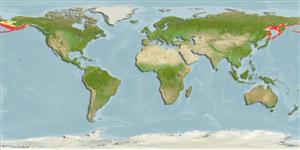Preferred temperature (Ref.
123201): 0.5 - 6, mean 3.3 °C (based on 339 cells).
Índice de diversidade filogenética (Ref.
82804): PD
50 = 0.7500 [Uniqueness, from 0.5 = low to 2.0 = high].
Bayesian length-weight: a=0.00794 (0.00679 - 0.00930), b=3.08 (3.04 - 3.12), in cm total length, based on LWR estimates for this species (Ref.
93245).
Nível Trófico (Ref.
69278): 3.6 ±0.1 se; based on diet studies.
Resiliência (Ref.
120179): Muito baixo(a), tempo mínimo de duplicação da população maior que 14 anos (K=0.09-0.2; tmax=37; tm=3-8;).
Prior r = 0.30, 95% CL = 0.20 - 0.45, Based on 3 full stock assessments.
Fishing Vulnerability (Ref.
59153): High to very high vulnerability (68 of 100).
🛈
Climate Vulnerability (Ref.
125649): High vulnerability (62 of 100).
🛈
Nutrients (Ref.
124155): Calcium = 29.9 [8.7, 59.9] mg/100g; Iron = 0.224 [0.088, 0.598] mg/100g; Protein = 17.3 [15.3, 19.9] %; Omega3 = 0.29 [0.14, 0.65] g/100g; Selenium = 37.3 [13.1, 106.2] μg/100g; VitaminA = 6.5 [1.5, 27.3] μg/100g; Zinc = 0.331 [0.171, 0.678] mg/100g (wet weight);
